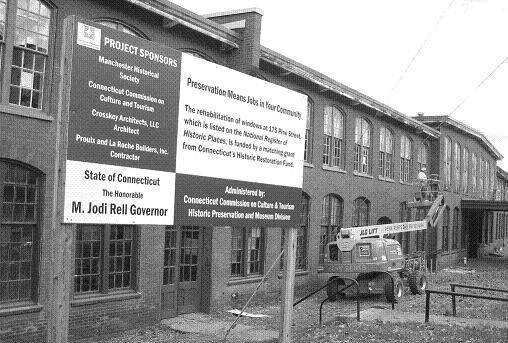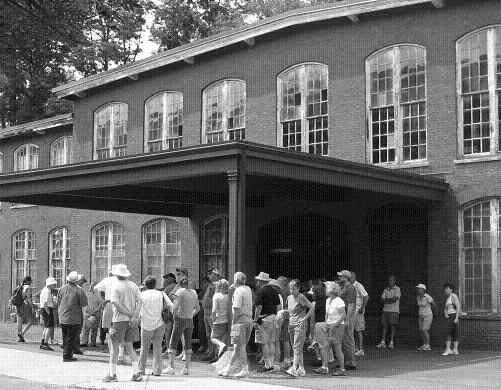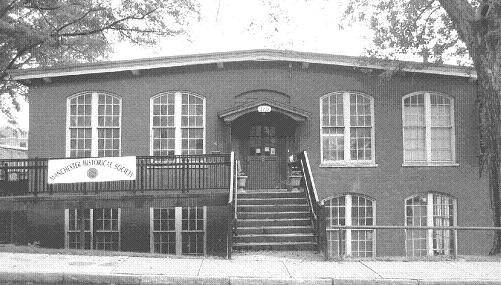
REPRINTS

In 1895, the Cheney brothers' silk mills were busy, and there was quite a building boom in the south end of Manchester.
Along with new silk mills, of course, came new looms and other machinery, more employees, many from overseas, and new
houses for the workers.
Velvet looms had come from Germany along with Richard Mommers (1846-1926), a German designer and manufacturer of
velvet-weaving looms. Cheney Brothers purchased looms from Mommers' firm in 1880, and stipulated that he accompany the
looms to Manchester to supervise the installation. When this task was complete, Cheneys offered him the position of
Superintendent of the Manufacture of Velvet, a position he held until his death in 1926 at the age of 80.
But any repairs to these looms would have to be done here in Manchester, because they couldn't be shipped back to
Germany for repair and maintenance.
In three main phases beginning in 1895, a huge machine shop was built along Forest Street, eventually reaching from
Elm Street all the way to Pine Street, and comprising 40,000 square feet of space, which included plumbing, painting, and
carpentry shops, two forges, and machinery to actually build looms.
The following 3 maps show the evolution of the machine shop and its surrounding properties. These were
prepared by the Sanborn Fire Insurance Company. Some of the out-buildings remain the property of the Historical
Society
In addition to working on looms and mills, the machine shop employees might be called to the public schools to repair
and maintain them, and also to the Cheney family houses, including the mansions along Hartford Road and Forest Street.
Until the 1950s, the heating for these mansions came from the steam plant at the mills, piped underground to each house.
A January 1905 Courant article notes, "Work continues to be rushing in the mills of Cheney Brothers and already
preparations are being made for the rush which is expected on velvet orders during the summer. Men are at work in Cheney
Brothers machine shop building thirty-four more velvet looms which are to be placed in the third, or south mill, of the new
block of velvet mills built a short time ago." (A remnant of the velvet-mill era is pointed out to participants in walking
tours of the area � a large letter "V" with a number painted in white on the brick walls of the velvet mill.)
Our 40,000-square-foot building is the former Cheney Brothers Machine Shop, constructed in several phases beginning in
1895. The Historical Society bought the building in 1999, and has completed several other projects, including a handicap
ramp, improved plumbing and safety features.
Passing of the Boom Years
The boom time for Cheney mills began to ebb during the late 1920s, and many of the mill buildings were re-used for purposes
other than silk. For example, in 1938, Cheneys rented out the third floor of a mill on Elm Street to Meyer Tober of
Hartford, who owned Tober Baseball Manufacturing Company. (Tober later rented space in Hilliard Mills, and eventually moved
the baseball factory to Rockville.) Pioneer Parachute began in the Clock Tower mill during the 1930s.
According to an October 1938 Courant article, "The silk firm has already leased several of its vacant factories to
small manufacturing concerns."
On the Forest Street side (lower level of the machine shop) David Rines (1926-2009), of Manchester, operated a one-man
machine shop from 1975 to 1995.
Ed. Note: You can read a 1982 article about Mr. Rines from The Manchester Herald by
clicking: Dave Rines reprint. Mr. Rines produced parts for experimental aircraft for the government and for Pratt & Whitney. He
produced prototypes and some armament items, too, in such a high-security environment that he refused to divulge information
about it even years later.
Security was always an issue with the Cheneys too, because their trade secrets and designs needed to be protected. They
used valuable and scarce metals, too, and there is a large walk-in vault in the machine shop.
Historical Society Purchase of the Old Machine Shop
In 1999, the Manchester Historical Society bought the machine shop, transforming it during the past decade into the
Manchester History Center, the location of the Society's administrative offices and events such as lectures, slide shows,
exhibits, and fundraisers.
Currently, the Society is working on restoration of the windows � a project that has been in the works for several years,
during which the Society obtained a grant, hired a preservation architect, raised money, and recently chose the contractor.
Now neighbors and passersby can watch the windows getting preserved one by one around the building.
John Dormer, the Historical Society's president, acting executive director, and window-project manager, said the windows
in the initial portion of the project will be finished by December 31. They will still look like old windows, he said, "but
they will be in good preserved condition, with no glass panes falling out, and with the damaged wood around the panes and
window openings replaced and painted inside and out. The contractor, Proulx & LaRoche Builders, Inc., is doing a great job,
and is here every day with a crew."
The window restoration project is being funded by a matching grant from Connecticut's Historic Restoration Fund,
administered by the Connecticut Commission on Culture and Tourism. The grant, not to exceed $140,000, will be matched with
money received by the ongoing "No Pane, No Gain Window Restoration Drive" and by existing Historical Society building funds.
Building Projects Will Continue
The window project will continue with more windows restored as donations continue to come in. Another part of the project
will be to install interior storm windows on certain windows to continue to improve energy efficiency.
The interior of the windows is being painted in a yellow-tone, which is the color discovered upon scraping down the
wood around the windows. Outdoors, the wood will be "Cheney green," which was the original color even though the wood has
been painted white for the past 50 years or so. John explained that each of 164 masonry opening have two windows, and "we
are currently restoring 200 windows, or 100 masonry openings. Some north-facing windows may be blocked off to reduce energy
costs and to provide more interior wall space for archival storage and exhibits As we continue, we hope to get donations
to restore another 64 windows. The Society appreciates all who have donated so far. Additional gifts can be sent directly
to the Historical Society," (mailing address 106 Hartford Road, Manchester, CT 06040).
Other projects already completed include a handicapped ramp, improved plumbing and safety features, and a new roof in
2007, a large-scale project funded by Save America's Treasures. John Dormer also supervised that project and he notes that
the new roof has resulted in a thirteen percent fuel savings on the upper level of the History Center.
The machine shop is in the heart of the Cheney Brothers National Historic Landmark District, along with other reminders
of Manchester's industrial past, including many silk mills converted to apartments. A new project starting this fall is the
transformation of the old dye house on the corner of Pine and Cooper Hill streets into apartments. This is one of the last
buildings in the area that is still vacant from the long ago days when Manchester was the Silk City and had an international
reputation for the highest quality silk.
Postscript:
Susan Barlow is a Director Emeritus of the Manchester Historical Society, which, in addition to the machine shop,
owns the Cheney Homestead on Hartford Road, the Keeney Schoolhouse on the grounds of the Homestead, and the Woodbridge Farmstead at Manchester Green. The Society operates the Old Manchester Museum at 126 Cedar Street, in space rented from the Town of Manchester.

Sign outside the History Center lists the names of the preservation architect, Crosskey Architects, and the
contractor: Proulx and La Roche Builders of Stafford Springs. To the right of the picture, a worker uses a lift truck
to reach the windows on the upper level.

